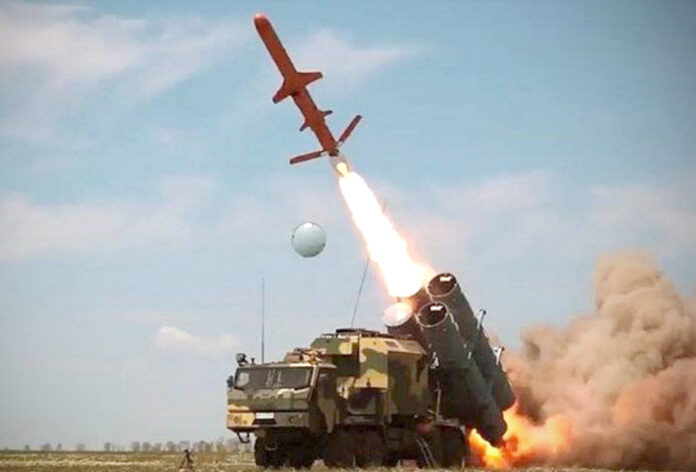Ukraine is adapting domestically-produced Neptune anti-ship missiles to bolster its long-range strike capabilities in its three-month-old counteroffensive, experts have suggested, after Kyiv publicized its “completely modern” weapon in action in Crimea.
Modified Neptune missiles, which Kyiv developed just before the outbreak of full-scale war in the country, “are part of a broader recent Ukrainian effort to increase its long-range strike capacity,” according to Ian Williams, deputy director of the Missile Defense Project at the Center for Strategic and International Studies.
Ukraine’s new Neptune anti-ship missiles had been credited with taking out Russia’s Black Sea flagship, the Moskva, in a high-profile embarrassment for the Kremlin just a few months into its now 18 month-old invasion.
But in recent weeks, Kyiv has teased the development of a land-attack version of the Neptune. Oleksiy Danilov, the secretary of Ukraine’s National Security and Defense Council, said a “new, completely modern” missile had worked “flawlessly” to take out a Russian air defense system in western Crimea in late August.
Ukraine used a revamped version of its Neptune missile, an anonymous Ukrainian defense official told The War Zone. The attack “was 100 percent carried out by a modified Neptune,” the unnamed official added.
With Ukraine’s need for long-range systems for striking far-off Russian targets outstripping its supply, Kyiv has adapted, analysts have told Newsweek.
Telegram
“In a perfect world, land-attack missions are not the best use for modern anti-ship missiles, which are specially designed to sink heavily armored warships at sea,” Williams said.
“But Ukraine is facing a real deficit in deep strike systems,” Williams added to Newsweek, meaning Kyiv is turning to these missiles because it does not have access to the U.S.’s ATACMS tactical ballistic missile system or the German-made Taurus long-range cruise missile. Both Washington and Berlin have declined to furnish Ukraine with these systems, despite London and Paris delivering the long-range Anglo-French Storm Shadow, or SCALP, cruise missiles earlier this year.
“Ukraine is adapting and using what it has on hand,” Williams argued, but it should not be seen as a long-term solution to Ukraine’s long-range strike needs.
The strike on western Crimea’s Cape Tarkhankut late last month “did prove that Ukraine can use Neptune in a land-attack mode and thus hold Russian assets at risk in previously safe rear areas,” said Sidharth Kaushal, a research fellow at the Royal United Services Institute defense think tank.
Striking a relatively small target that can intercept air threats like the S-400 suggests Ukraine has high-quality intelligence and reconnaissance, and that the land-attack Neptune may be able to hide behind obstacles to approach unseen by Russia, Kaushal told Newsweek. It could also hint that the Neptune might use countermeasures against being detected, or else be used alongside jamming equipment, he continued.
“All of this would point to fairly sophisticated coordination of capabilities by the Ukrainians,” although there are many unknown factors, Kaushal said.
Although it is hard to tell, one likely difference between the land-attack version of the Neptune and the anti-ship variant would be the guidance system, Kaushal added. It may also have “a different seeker to allow a missile to pick out a smaller target from clutter,” he said.
It is difficult to judge how many Neptune missiles Ukraine is likely to have at its disposal, but it’s unlikely to be an extensive inventory. It is difficult to mass-produce this type of capability even in peacetime, and Russia has gone to great lengths to target Ukraine’s military-industrial base, Kaushal said.


